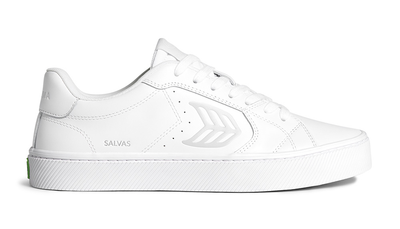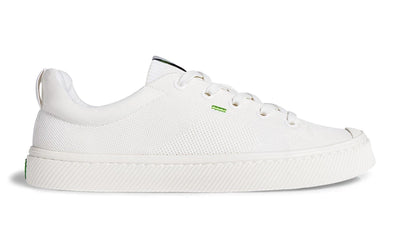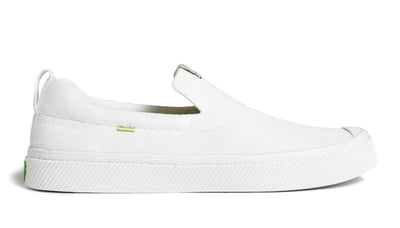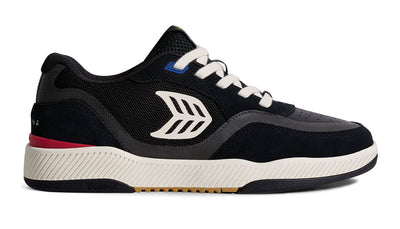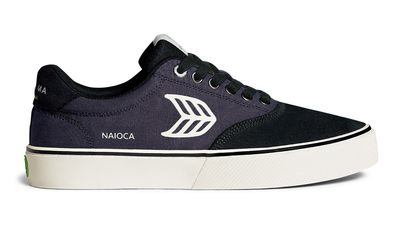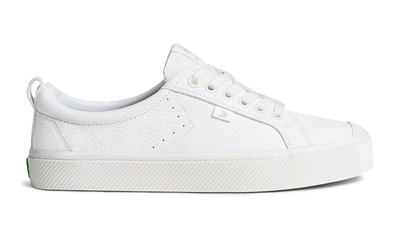What is Ethically Sourced Leather?
Leather has been used for thousands of years as an especially durable and versatile material, and it remains one of the most popular for high-quality shoes, jackets, bags, and more. It’s no wonder they’re an everyday staple for many—with proper storage and the occasional clean, leather shoes just look better with age.
When you buy a pair of our premium leather sneakers, you’re investing in something that’s truly made to last. Committed to inspire change throughout the fashion industry, we make conscious decisions in the sourcing of our leather to create comfy, durable, and ethically crafted shoes.
We’re often asked how our leather and suede differ from their conventional counterparts. Here’s how:
When you buy a pair of our premium leather sneakers, you’re investing in something that’s truly made to last. Committed to inspire change throughout the fashion industry, we make conscious decisions in the sourcing of our leather to create comfy, durable, and ethically crafted shoes.
We’re often asked how our leather and suede differ from their conventional counterparts. Here’s how:
What is Ethically Sourced Leather?
Leather has been used for thousands of years as an especially durable and versatile material, and it remains one of the most popular for high-quality shoes, jackets, bags, and more. It’s no wonder they’re an everyday staple for many—with proper storage and the occasional clean, leather shoes just look better with age.
When you buy a pair of our premium leather sneakers, you’re investing in something that’s truly made to last. Committed to inspire change throughout the fashion industry, we make conscious decisions in the sourcing of our leather to create comfy, durable, and ethically crafted shoes.
We’re often asked how our leather and suede differ from their conventional counterparts. Here’s how:
When you buy a pair of our premium leather sneakers, you’re investing in something that’s truly made to last. Committed to inspire change throughout the fashion industry, we make conscious decisions in the sourcing of our leather to create comfy, durable, and ethically crafted shoes.
We’re often asked how our leather and suede differ from their conventional counterparts. Here’s how:
What makes a "better" leather?
Compared to the industry average leather, our premium and certified materials are sourced, tanned, and finished with low-waste methods, renewable and recycled inputs, and less chemicals. Our responsible practices involve recycled water, renewable energy and a closed-loop tanning chemical system to protect the surrounding land and groundwater.
From raw material until the finished leather, all operations take place within Cariuma-nominated supplier facilities, ensuring traceability and visibility. Most importantly, our leather is never sourced from any area that has been deforested for cattle-farming.
Our leather is exclusively a byproduct of best-practice food industry cattle: steroid-free and grass-fed on pampas (naturally treeless plains indigenous to South America). All of the leather and suede used in our shoes is responsibly sourced from the United States, Brazil and Argentina.
From raw material until the finished leather, all operations take place within Cariuma-nominated supplier facilities, ensuring traceability and visibility. Most importantly, our leather is never sourced from any area that has been deforested for cattle-farming.
Our leather is exclusively a byproduct of best-practice food industry cattle: steroid-free and grass-fed on pampas (naturally treeless plains indigenous to South America). All of the leather and suede used in our shoes is responsibly sourced from the United States, Brazil and Argentina.
Are there certifications for leather suppliers?
Our leather suppliers are Gold-Rated by the Leather Working Group (LWG), which provides the most reliable seal of approval when it comes to sustainability in the leather industry. Our suppliers have completed the LWG Manufacturer Audit, a stringent set of protocols that address the traceability and environmental impact of the entire supply chain.
How is leather tanned?
Tanning is the process of treating the hides to create leather. Tanning leather involves a series of chromium baths, which affects the proteins in the hide to make it durable, preventing decomposition and discoloration.
Overall, the energy footprint of our leather is 53% smaller than that of conventional leather. Our suppliers’ solution is holistic, to ensure the smallest footprint possible. While the majority of tanneries use coal and natural gas boilers, our supplier uses solar panels to heat water to up to 70ºC. In fact, 100% of our suppliers’ thermal energy comes from renewable sources like solar panels and biomass (primarily upcycled wood from the furniture industry).
Our suppliers also generate electrical energy from renewable hydro-generated sources; use LED and natural lighting; and heat their facilities by recycling gas emissions from the boilers into thermal energy.
Overall, the energy footprint of our leather is 53% smaller than that of conventional leather. Our suppliers’ solution is holistic, to ensure the smallest footprint possible. While the majority of tanneries use coal and natural gas boilers, our supplier uses solar panels to heat water to up to 70ºC. In fact, 100% of our suppliers’ thermal energy comes from renewable sources like solar panels and biomass (primarily upcycled wood from the furniture industry).
Our suppliers also generate electrical energy from renewable hydro-generated sources; use LED and natural lighting; and heat their facilities by recycling gas emissions from the boilers into thermal energy.
How much water is used to process leather?
After contact with both the leather and tanning chemicals, our suppliers treat and recycle the water used throughout the process. Start to finish, our suppliers use 71% less water than the conventional estimate, with the help of efficiency-boosting filtration and advanced water efficiency technology (located inside the tanning drums). All facilities contain state-of-the-art water treatment stations, to recycle water and purify effluents, to prevent waterway pollution. The result is 78% less nutrient run-off into bodies of water.
What chemicals are used to process leather?
Compared to the industry average, our suppliers reduce the chemical waste of leather tanning by 64%.* Chromium is recycled from various stages in the process, from tanning bath and chrome re-tanning bath, to chrome liquor and sammying machine. This recycled substance is transformed to basic chromium sulphate, the principle tanning agent.
How does the carbon footprint of Cariuma leather compare with conventional leather?
On average, LWG Gold-Rated leather has a 71% lower carbon footprint than conventional leather.*
You can find more about our Animal Welfare policy here.
*Calculated using the Higg Materials Sustainability Index (Higg MSI at Higg.org), with industry average data provided by the Sustainable Apparel Coalition (SAC): Chemistry units of environmental impact developed by SAC, incorporated into the Higg MSI platform.
You can find more about our Animal Welfare policy here.
*Calculated using the Higg Materials Sustainability Index (Higg MSI at Higg.org), with industry average data provided by the Sustainable Apparel Coalition (SAC): Chemistry units of environmental impact developed by SAC, incorporated into the Higg MSI platform.
What makes a "better" leather?
Compared to the industry average leather, our premium and certified materials are sourced, tanned, and finished with low-waste methods, renewable and recycled inputs, and less chemicals. Our responsible practices involve recycled water, renewable energy and a closed-loop tanning chemical system to protect the surrounding land and groundwater.
From raw material until the finished leather, all operations take place within Cariuma-nominated supplier facilities, ensuring traceability and visibility. Most importantly, our leather is never sourced from any area that has been deforested for cattle-farming.
Our leather is exclusively a byproduct of best-practice food industry cattle: steroid-free and grass-fed on pampas (naturally treeless plains indigenous to South America). All of the leather and suede used in our shoes is responsibly sourced from the United States, Brazil and Argentina.
From raw material until the finished leather, all operations take place within Cariuma-nominated supplier facilities, ensuring traceability and visibility. Most importantly, our leather is never sourced from any area that has been deforested for cattle-farming.
Our leather is exclusively a byproduct of best-practice food industry cattle: steroid-free and grass-fed on pampas (naturally treeless plains indigenous to South America). All of the leather and suede used in our shoes is responsibly sourced from the United States, Brazil and Argentina.
Are there certifications for leather suppliers?
Our leather suppliers are Gold-Rated by the Leather Working Group (LWG), which provides the most reliable seal of approval when it comes to sustainability in the leather industry. Our suppliers have completed the LWG Manufacturer Audit, a stringent set of protocols that address the traceability and environmental impact of the entire supply chain.
How is leather tanned?
Tanning is the process of treating the hides to create leather. Tanning leather involves a series of chromium baths, which affects the proteins in the hide to make it durable, preventing decomposition and discoloration.
Overall, the energy footprint of our leather is 53% smaller than that of conventional leather. Our suppliers’ solution is holistic, to ensure the smallest footprint possible. While the majority of tanneries use coal and natural gas boilers, our supplier uses solar panels to heat water to up to 70ºC. In fact, 100% of our suppliers’ thermal energy comes from renewable sources like solar panels and biomass (primarily upcycled wood from the furniture industry).
Our suppliers also generate electrical energy from renewable hydro-generated sources; use LED and natural lighting; and heat their facilities by recycling gas emissions from the boilers into thermal energy.
Overall, the energy footprint of our leather is 53% smaller than that of conventional leather. Our suppliers’ solution is holistic, to ensure the smallest footprint possible. While the majority of tanneries use coal and natural gas boilers, our supplier uses solar panels to heat water to up to 70ºC. In fact, 100% of our suppliers’ thermal energy comes from renewable sources like solar panels and biomass (primarily upcycled wood from the furniture industry).
Our suppliers also generate electrical energy from renewable hydro-generated sources; use LED and natural lighting; and heat their facilities by recycling gas emissions from the boilers into thermal energy.
How much water is used to process leather?
After contact with both the leather and tanning chemicals, our suppliers treat and recycle the water used throughout the process. Start to finish, our suppliers use 71% less water than the conventional estimate, with the help of efficiency-boosting filtration and advanced water efficiency technology (located inside the tanning drums). All facilities contain state-of-the-art water treatment stations, to recycle water and purify effluents, to prevent waterway pollution. The result is 78% less nutrient run-off into bodies of water.
What chemicals are used to process leather?
Compared to the industry average, our suppliers reduce the chemical waste of leather tanning by 64%.* Chromium is recycled from various stages in the process, from tanning bath and chrome re-tanning bath, to chrome liquor and sammying machine. This recycled substance is transformed to basic chromium sulphate, the principle tanning agent.
How does the carbon footprint of Cariuma leather compare with conventional leather?
On average, LWG Gold-Rated leather has a 71% lower carbon footprint than conventional leather.*
You can find more about our Animal Welfare policy here.
*Calculated using the Higg Materials Sustainability Index (Higg MSI at Higg.org), with industry average data provided by the Sustainable Apparel Coalition (SAC): Chemistry units of environmental impact developed by SAC, incorporated into the Higg MSI platform.
You can find more about our Animal Welfare policy here.
*Calculated using the Higg Materials Sustainability Index (Higg MSI at Higg.org), with industry average data provided by the Sustainable Apparel Coalition (SAC): Chemistry units of environmental impact developed by SAC, incorporated into the Higg MSI platform.


Beyond the Sneakers
Our mission to disrupt the wasteful practices inherent in fashion goes beyond ethically sourced and processed materials. Throughout the leather supply chain, our production partners pay their employees fair wages and provide healthy working conditions—as a WRAP-certified Gold rated supplier, we ensure this through traceability efforts, enforced and maintained by experts in the field of human rights.
To complete this cycle, our ethical leather shoes reach you, our customers, in a conscious manner. We created our very own single-box packaging made from recycled and recyclable paper to reduce waste.
We’re on a mission to make the world greener with every sneaker purchased. For every pair, you plant two trees through our in-house ecological restoration initiative.
To complete this cycle, our ethical leather shoes reach you, our customers, in a conscious manner. We created our very own single-box packaging made from recycled and recyclable paper to reduce waste.
We’re on a mission to make the world greener with every sneaker purchased. For every pair, you plant two trees through our in-house ecological restoration initiative.


Beyond the Sneakers
Our mission to disrupt the wasteful practices inherent in fashion goes beyond ethically sourced and processed materials. Throughout the leather supply chain, our production partners pay their employees fair wages and provide healthy working conditions—as a WRAP-certified Gold rated supplier, we ensure this through traceability efforts, enforced and maintained by experts in the field of human rights.
To complete this cycle, our ethical leather shoes reach you, our customers, in a conscious manner. We created our very own single-box packaging made from recycled and recyclable paper to reduce waste.
We’re on a mission to make the world greener with every sneaker purchased. For every pair, you plant two trees through our in-house ecological restoration initiative.
To complete this cycle, our ethical leather shoes reach you, our customers, in a conscious manner. We created our very own single-box packaging made from recycled and recyclable paper to reduce waste.
We’re on a mission to make the world greener with every sneaker purchased. For every pair, you plant two trees through our in-house ecological restoration initiative.

